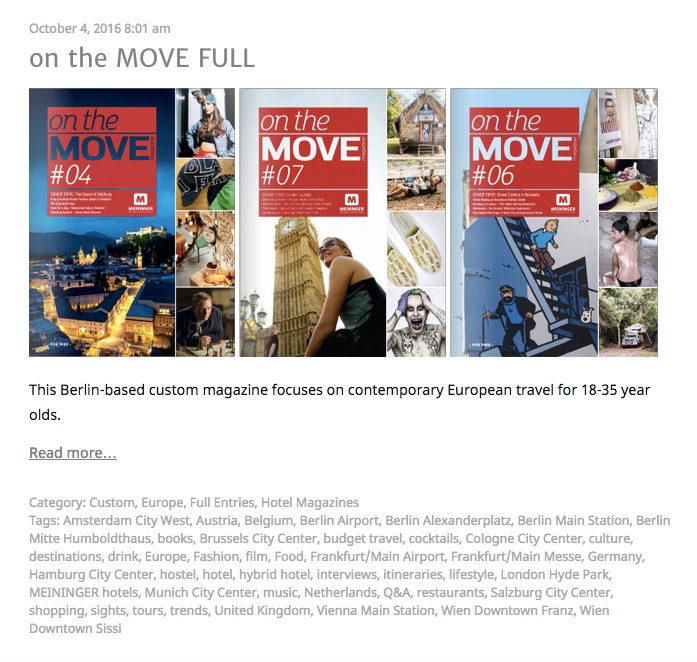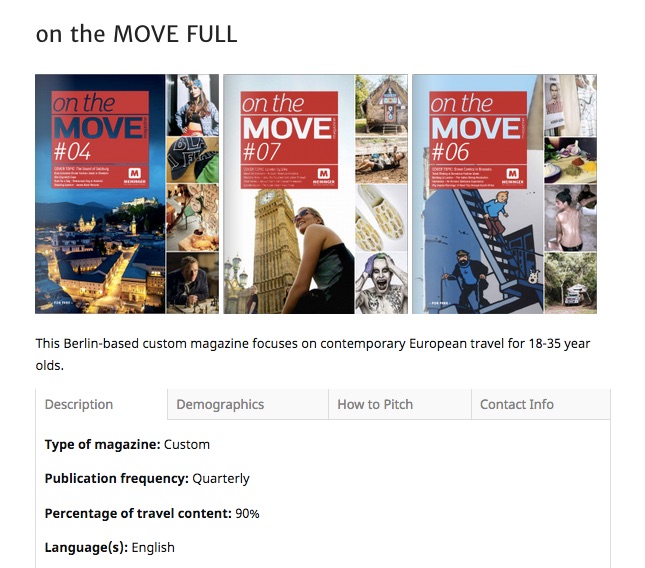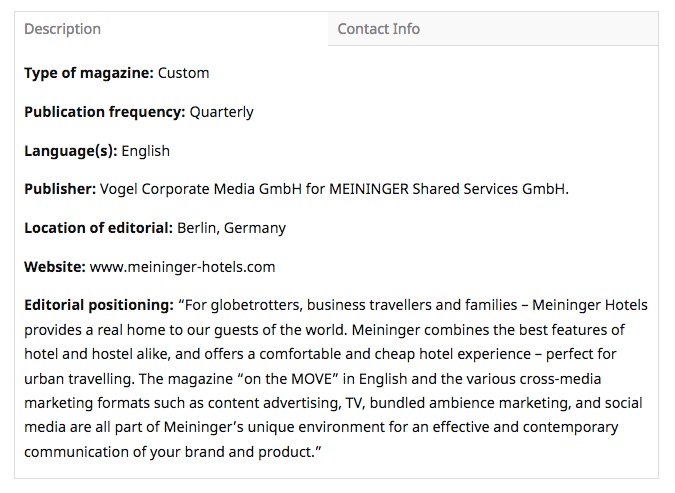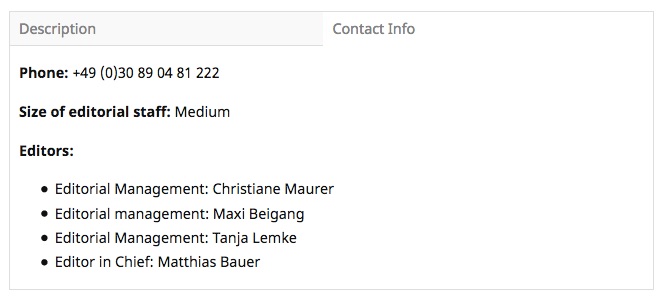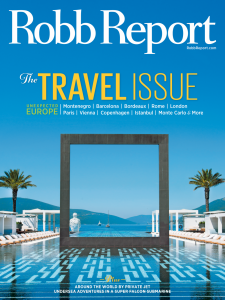
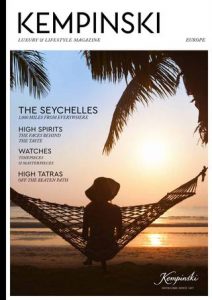
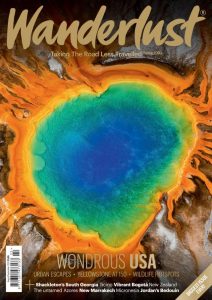
The Travel Magazine Database is not a giant rolodex.
It’s a database that provides detailed, curated information how to pitch information on more than 500 magazines so you can get paid to write.
Here’s how the Travel Magazine Database is going to help you achieve your goals:
→ In order to earn more money as a travel writer, you need more assignments.
→ In order to land more assignments, you need to pitch more often to more outlets.
→ In order to pitch more, you need information readily available to you on what + how to pitch each story to…
…and that’s exactly what the Travel Magazine Database provides.
Looking for registration? Members log-in: click here.
What’s the Travel Magazine Database?
It’s a searchable database designed to give you clear direction on how to pitch to more than 500 travel magazines including…
NATIONAL GEOGRAPHIC TRAVELER
COASTAL LIVING
SOUTHWEST AIRLINES MAGAZINE
SOUTHERN LIVING
LUXURY TRAVEL
TRAVEL + LEISURE
CONDE NAST
SAVEUR
SUNSET
DELTA SKY
HEMISPHERES
and so so so many more…
NEW MAGAZINES ADDED WEEKLY!
Make your hours count and spend them pitching and writing, not researching.
“It’s a no-brainer; you need to get your database. There is nothing else out there like it.
Before Gabi and the database, I was not pitching anywhere near as often, nor anywhere near as seriously. It would take me hours of research to find 2-3 outlets to pitch. Right now, I have 10 assignments — a year ago, if I could place one article in 6 months that would be amazing.”
– Christine Hinz, Freelance Travel Writer
If you want to hit $1,000 per month, or $3,000 per month, or $6,000 per month, or even $10,000 per month writing travel articles you can.
All it takes is consistently sending out solid pitches.
You may be thinking “I don’t have the time to invest in my travel writing right now.”
Let’s talk about how you’re currently spending your time as a writer:
- You’re reading articles online (hey, you found this page)
- You’re soaking up free, valuable information on travel writing
- You’re (hopefully) researching magazines to send pitches to
What if, instead of falling down an internet rabbit hole, you were focused and powerful in how you approached that time?
What if your time was spent on just these three things:
- Sending pitches.
- Writing articles.
- Collecting money.
Imagine if all you had to do was log in, search, match and pitch.
What else would you be able to do?
What else would you have time for? How many more articles would you be able to write (and get paid for)? How much more money would that add to your bank account?
Chances are, you’d finally be able to…
- send time-efficient, successful pitches
- gain connections for repeat work (and recurring assignments)
- pitch new publications for a “yes”
- stay relevant and consistent with your story ideas
- increase your income with travel writing
- find the right outlets for your ideas
- craft effective pitches that work
The trick is getting targeted with your ideas and pitches, and pitching a lot. But it doesn’t have to be time-consuming.
Join the Travel Magazine Database & Start Pitching Now
Inside the Travel Magazine Database
Each magazine listing includes four signature sections:
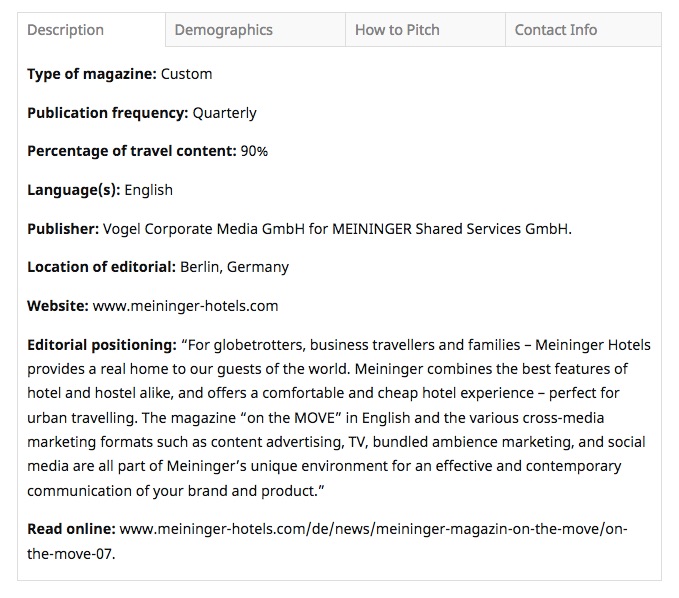
1. What is the Magazine All About?
- What type of magazine is it? Consumer? Custom? Trade?
- How often does it come out?
- What percentage of the articles in the magazine is travel-based content?
- Who publishes the magazine?
- Where are the located?
- How do the editors describe the positioning of their magazine?
- Where can you read full issues of the magazine online?
- Are they available for free online or only on paid online newsstands?
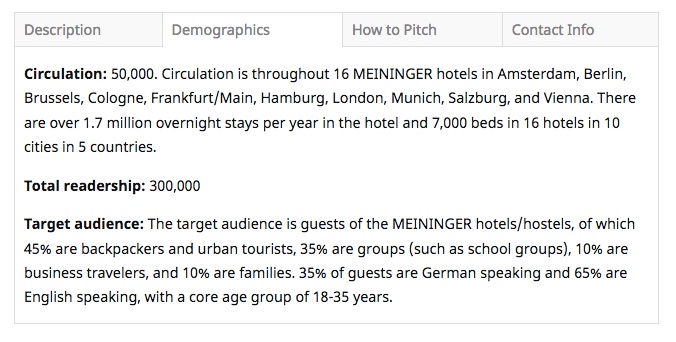
2. Who is the Magazine’s Audience?
- How many people subscribe to the magazine?
- How many total people read the magazine? (some magazines get big boosts in readership from “pass-through” readers or locations like doctors’ offices)
- How old are the readers?
- What is the average income of the magazine’s readers?
- What activities do the readers enjoy?
- How frequently do they travel?
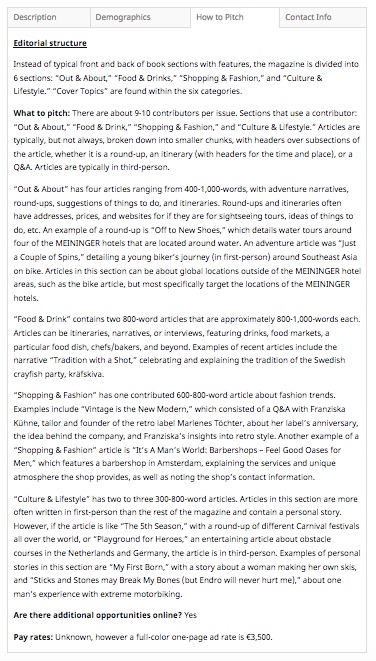
3. How Can You Pitch this Specific Magazine?
- How is the magazine laid out?
- How many sections are open to freelance writers?
- Which sections are not open to freelance pitches?
- How long are the sections you can pitch?
- What is the tone of those sections?
- How are the sections open to freelanceres structured?
- What kind of stories have they published in the past?
- Are there additional opportunities to pitch the magazines online section?
- How much does the magazine pay?
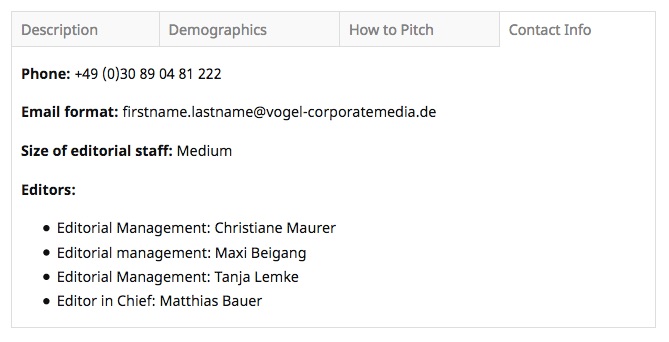
4. Who Do You Pitch and How Do You Reach Them?
- Which editors should you target your pitches to?
- How can you email them?
Want to know more? You can check out a full demo of the database:
As a member, you’ll also get these bonuses when you join…
BONUS #1:
THE ULTIMATE GUIDE TO PITCHING AND LANDING TRAVEL MAGAZINE ARTICLES ($59 value)
This 180-page manual is complete with everything you need to know to pitch like a professional. Pitching is the single biggest way to up your publishing track record. While most aspiring, struggling, and even working writers flounder in this area, YOU don’t have to. This guide will walk you through…
- The MINDSET of pitching (and how to psych yourself up instead of talk yourself down)
- When to pitch for the best outcome and other commonly asked questions!
- What magazines really pay and how to project your pay accordingly
- The PROCESS of pitching (step-by-step) for new and experienced writers
- BONUS Worksheets – including how to match your idea to a magazine!
BONUS #2:
WEBINAR: HOW TO BREAK YOUR TRIPS INTO THE MAXIMUM NUMBER OF ARTICLE PITCHES ($19 value)
Learn how to get multiple assignments from ONE trip so you can make the most out of your travel agenda! The most successful travel writers don’t limit themselves to one article per trip, and neither should you. We’ll cover sample itineraries and how these translate into article ideas and pitches.
BONUS #3:
WEBINAR: HOW TO GENERATE SUREFIRE SALEABLE IDEAS ($19 value)
Before you send a pitch or even worry about matching your idea to the right magazine, you want to make sure your idea is saleable. This webinar will take you behind-the-scenes of the business of travel writing, so you can nurture the ideas that are most likely to sell.
BONUS #4:
WEBINAR: THE MAGAZINE LANDSCAPE: WHERE ALL THE ASSIGNMENTS ARE HIDING ($19 value)
Ever wonder what you really have to do in order to get an assignment? The answer? PITCH! And not just MORE, but BETTER. The best way to devise pitches is to know what magazines are looking for first, and shape how you filter the memories from your journeys around what the magazine wants. This webinar will walk you through the landscape of travel magazines so you can improve your pitching – and therefore your success rate!
All totaled, the Travel Magazine Database and Bonus Bundle is valued at well over $10,000.
That’s a ton of money! Right?
But we’ve spent more than that on magazine acquisitions, researchers, and writers to create this resource for YOU.
It can take anywhere from two to five hours to analyze EACH magazine you’ll find in the database. We’ve already got more than 500 magazines in there and we add NEW MAGAZINES every week.
We also have a member of our team dedicated to reveiewing our past entries each month to spot:
- new editors
- editor promotions
- magazine sections added and removed
- complete magazine revamps
- changes in frequency (bimonthly to monthly means twice as many publication opportunities for you!)
A membership like costs publicists more than $3,000 a year for the most basic version with just one licence.
And those databases don’t even include the type of in-depth how-to-pitch information we have, with instructions on how to pitch each individual section of the magazine.
Your investment is only $20 per month. That’s it.
Join the Travel Magazine Database & Start Pitching Now
“These seem like great, easy-to-pitch pieces that don’t necessarily always require a ton of prior travel. There are so many awesome indie travel magazines out there! I had no idea that so many of them were looking for first person narratives as features!
Before the database, I had no idea there were so many AAA-affiliated magazines. So many of them have “Weekender” type sections with small to larger itineraries for locations both within and outside of the specific magazine’s area of focus.
These seem like awesome opportunities to share the communities I know well with a variety of different geographic audiences!
And even though I love writing about local food and craft beer, it never occurred to me to pitch that type of “travel” content to a magazine like bon appetit, Lucky Peach, or one of the edible city-specific magazines.
Duh. I also noticed quite a few publications that had “Here and Now” and “What’s Hot” type sections specific to travel trends or timely issues.
These seem like great, easy-to-pitch pieces that don’t necessarily always require a ton of prior travel.
There are so many wonderful magazines in the database that I can’t wait to keep digging and start thinking through how their sections and themes could be good fits for what I’m already doing.
Thanks so much!”
– Megan Bannister, Freelance Travel Writer
Our Story
The Travel Magazine Database was founded by Gabi Logan when she realized that travel writers needed a resource that would help them approach editors (and their career) more strategically.
Back in the early 2010s, Gabi was a successful travel writer herself and, while attending conferences, she found that people would sort of freak out when they heard that she was making good money writing about travel full-time for (mostly) print magazines.
She would constantly get asked for advice and wouldn’t know where to point people — mostly because there was lots of great information out there, but there wasn’t ONE comprehensive resource that covered all the bases.
After finally getting sick of not being able to hand them ONE solution, she wrote her book The Six-Figure Travel Writing Roadmap and created Dream of Travel Writing, a company committed to helping travel writers build the career of their dreams. Dream of Travel Writing teaches the nitty-gritty reality, craft, and business of travel writing with free articles, paid trainings, and low-cost resources.
It was also attending conferences that Gabi realized that while many travel writers are struggling to get assignments, editors are equally challenged to find stories to publish and place. Editors want to hear great pitches just as much as writers want to hear “YES, I’ll pay you to write it!”
So the Travel Magazine Database was born as a bridge to connect magazine editors with travel writers by giving writers exactly what magazines are looking for, and how to pitch for a yes.
Gabi continues to attend nearly 40 conferences per year, and speak to hundreds of editors. She is constantly expanding the network in the database to make sure that it has the most up-to-date industry information possible.
If you’re serious about getting paid for your travel writing, this database was made for you.
Join the Travel Magazine Database & Start Pitching Now
Membership Tiers
| What's included: | Limited Access $5/ month | Full Access $20/month $200/year (save $40) |
|---|---|---|
| Listings of more than 500 magazines | ✅ | ✅ |
| Each magazine's editorial positioning | ✅ | ✅ |
| Full list of each magazine's editors | ✅ | ✅ |
| Editors' email address | ❌ | ✅ |
| Insights into each magazine's audience | ❌ | ✅ |
| Breakdown of which magazine sections are open to freelance writers | ❌ | ✅ |
| Full breakdown of each article open to freelancers, including word count, style, and article structure | ❌ | ✅ |
| Expected pay rates | ❌ | ✅ |
| Examples of past articles in each section open to freelancers | ❌ | ✅ |
| Links to read full issues online | ❌ | ✅ |
| BONUS 1: THE ULTIMATE GUIDE TO PITCHING AND LANDING TRAVEL MAGAZINE ARTICLES ($59 value) | ❌ | ✅ |
| BONUS 2: WEBINAR: HOW TO BREAK YOUR TRIPS INTO THE MAXIMUM NUMBER OF ARTICLE PITCHES ($19 value) | ❌ | ✅ |
| BONUS 3: WEBINAR: HOW TO GENERATE SUREFIRE SALEABLE IDEAS ($19 value) | ❌ | ✅ |
| BONUS 4: WEBINAR: THE MAGAZINE LANDSCAPE: WHERE ALL THE ASSIGNMENTS ARE HIDING ($19 value) | ❌ | ✅ |
Ready to get started?
- When you join, you’ll be billed for a monthly membership (unless you choose to pay in full for the year and save $40!).
- Your login details will be sent to you via email and you’ll receive immediate access to the Travel Magazine Database!
- You can get to searching, pitching, and writing – right away!
- You’ll land those new assignments, enjoy your travel writing dream, and thank us later. 🙂
You might be thinking…
“I don’t have the money! I need my travel writing to bring in more cash first.”
Totally get it. We all start somewhere.
That said, this database has all of the information you need to go pitch yourself for assignments that will pay up to $3,000, and sometimes more, depending on the magazine.
There is nothing else like this on the market that will make pitching for a “yes” easier for you.
If you’re ready to take your travel writing career seriously, this database is a necessary part of the puzzle.
The question is… where do you want to be in 3 months?
Do you want to be….
- Pitching more regularly because you have all the info you need at your fingertips
- Earning more money as a travel writer because you’re getting more assignments
- Doing multiple stories off of one trip because it’s easy to search more potential outlets?
OR
Do you want to be…
- In the same place you’re in now.
- Still struggling to find the valuable information you need for pitching success.
- Still making mediocre money, receiving few assignments, and making excuses as to why you “can’t?”
There’s no shame in your answer, but if you’re ready to make your travel writing success easier, the choice is simple.
“Before I started using the database, there was a pretty small number of magazines I was aware of.
Pitching was happening very rarely.
It was very erratic and frenzied. I could spend all day researching, which was really procrastination. I would waste so much time that wasn’t netting me any money.
And I had previously worked on a few editorial teams. The Frisky. Conde Nast. So I was an editor! People were pitching me all the time and I didn’t know how to pitch.
Between the database and Gabi’s lessons, pitching became really simple. I was surprised that it was so simple and formulaic. It felt really weird to pitch to someone I didn’t know. I felt like “It’s a waste of time but I feel like I have to.” But some people were interested right away!
In the database, everything is laid out and searchable so there is nothing stopping you.
There were also a lot of magazines in there I’ve never heard of and could never track down on my own.
The value for the subscription itself is beyond. It saves you so much time. You don’t have to go to the bookstore and flip through magazines. It shows you so many magazines that most people don’t know exist and don’t know how to pitch.
If I didn’t have this database, it would severely limit my options when I wanted to pitch a story, it would shut me off from a lot of potential income and career growth. All in all, The Travel Magazine Database saves me a lot of hassle.”
– Claire Hannum, Freelance Travel Writer
Join the Travel Magazine Database & Start Pitching Now
[GET STARTED FOR JUST $20]
FAQs
Q: What’s your refund policy? What if I join and don’t like it?
The Travel Magazine Database is a subscription based service. You’ll be billed $20 per month every month to maintain access. (Or $5 per month if you choose limited access.) There is no contract. If you join and don’t like it, you can cancel at any time and we will stop payments and remove you from the database.
It’s just like Netflix or Hulu or any other online subscription. You can cancel on your own at any time with a click of a button.
Q: Is this worth the investment? $20 per month or $200 upfront is a big investment for me right now as my travel writing hasn’t been very lucrative just yet!
We totally hear you. In the beginning, it can be challenging to nail your pitches and get assignments. However, the only way to get better at this is with practice. All things considered, this database is a very low cost of entry at $20 per month.
If all the database did for you was help you get ONE more paid writing assignment this year, it would have paid for itself. You are always welcome to start at the $5 limited access level.
And here’s the thing – if you’re not hitting your income goals, there are typically three reasons why. Either:
- you’re now pitching enough;
- you’re not pitching strategically; or
- you’re giving up too easily.
This doesn’t mean there’s anything wrong with you!
You have the potential to make six figures as a freelance travel writer. But in order to create that travel writing career of your dreams, you need to know WHO to pitch to, WHAT to pitch for a YES, and the nerve to hit “send.”
We can’t give you the nerve, but we can give you the WHO and the WHAT. The rest is up to you.
Q: What if I join and still don’t get assignments?
We’d encourage you to use all of the bonus material we’re supplying and watch the introductory video on how to best use the database as well.
The database does not include any custom feedback, support, coaching or matching — but if you use all of the provided materials you will have everything you need to nail it!
And if you’re not getting assignments because you’ve subscribed to the database but you’re still not doing the work or sending pitches… well, then we can’t help you there! If you want to build a successful career, you have to be willing to put in the work.
We do have one solution though.
If you use the Travel Magazine Database for three months to pitch regularly and get no responses whatsoever, not only will we give you all of your money back, we will also give you three pitch-letter critiques and a coaching call to get your pitching on track so you do get responses from editors.
*****
A final note from our founder…
Look, I know that pitching is scary. Putting yourself out there like that can bring up all kinds of things. It’s painful to get rejected. You might find yourself procrastinating to avoid doing it. It might make you think things like “who am I to get paid to write this article??”
You might feel like an imposter. It might make you hesitate before hitting “send” or rewriting your pitch 1000 times over. You might deal with perfectionism x 1000.
But the only way to get over that is to keep taking action in spite of your fear. The truth is that your desire for a career in travel writing — for getting paid to go on adventures and write, for having total flexibility and freedom with your schedule, and seeing your name in print in magazines and online publications — has to be bigger than all of the fears that are holding you back.
There are so many writing opportunities available to you as a travel writer.
If you want to get paid for writing you have to go out there and ask for those paid assignments.
I created The Travel Magazine Database to make that process easier on you.
It will allow you to search magazines and learn who to contact, how to approach them, and what they specifically need for their publication – setting you up for a big, fat YES every time. It is almost like a living thing, in that it’s constantly being updated and added to.
My dream is that every travel writer out there is able to save hours of time and land way more assignments as a result of this database.
See, I believe that earning great money as a travel writer doesn’t have to be so hard. And I believe that YOU deserve to have the career of your dreams too. But I can’t do the work for you. You have to decide that your dreams are worth the work — that seeing your name in print, getting paid to do something you love, and actually having things work out is what you really want.
If you’re ready to take your travel writing career to the next level, this database and bonus bundle is here for you!
Gabi
p.s. Do you know what is one of my favorite editor responses from a database user? She told me: “I just had an editor compliment me on my ‘well-targeted pitch!'”
Want to get started? Register here!



